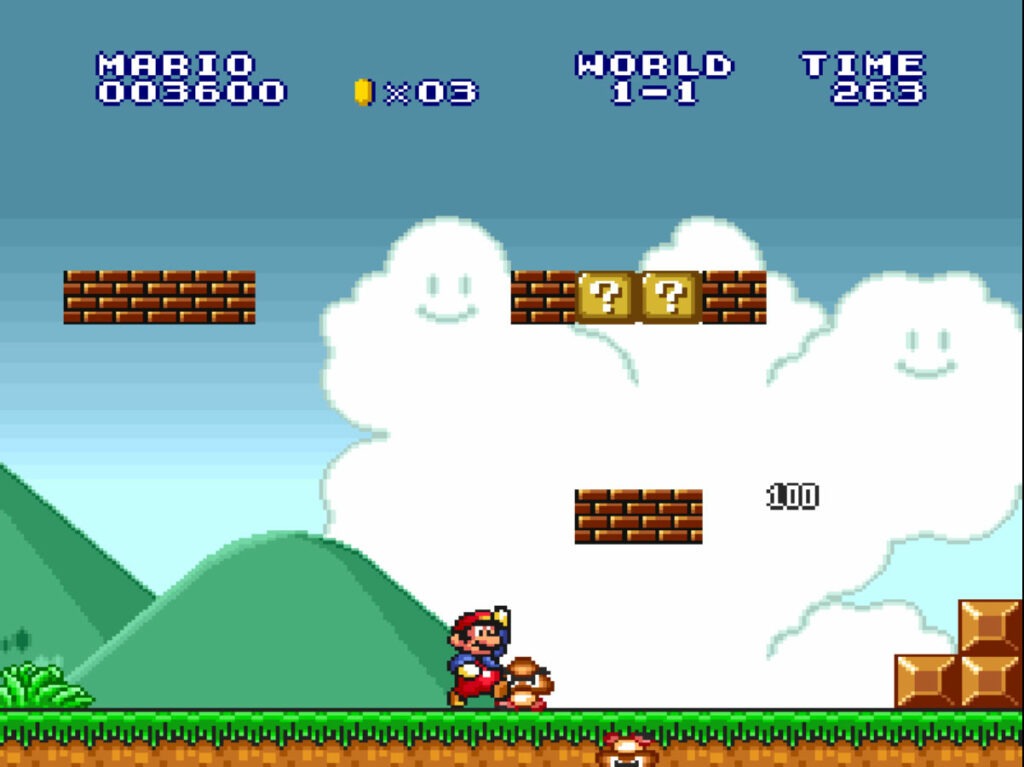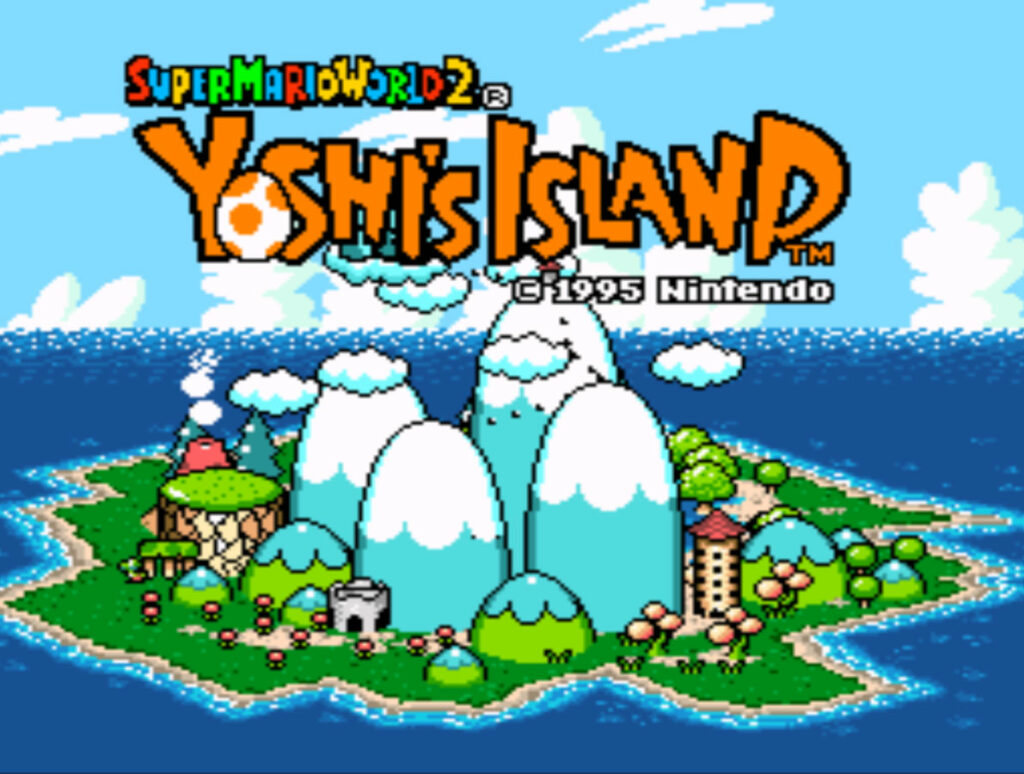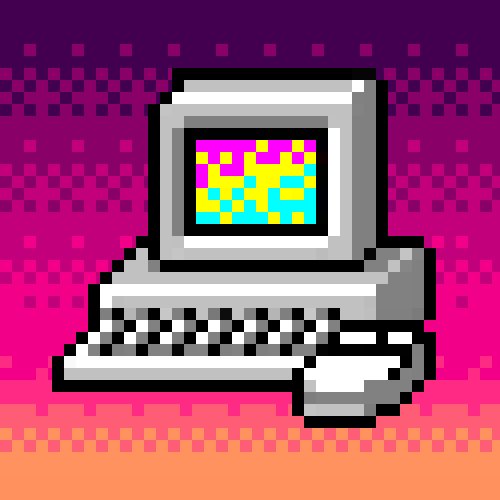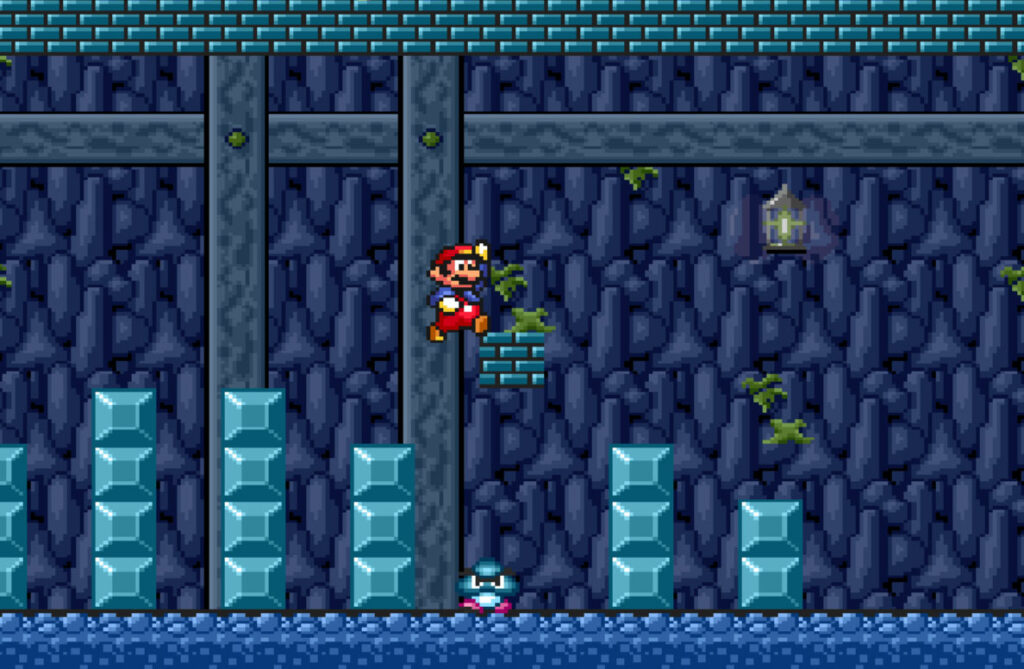Imagine a game developer only having a few colors. That was the 8-bit era, bursting with charm, yet limited in 56 colors. But soon, this palette expanded. The 16-bit era rolled in, jumping up to 256 colors, adding vivid new shades and colors to our painter’s toolkit. At the heart of this colorful revolution was the Super Nintendo Entertainment System.
The SNES ushered in a new, more advanced palette. With it, game developers built deeper stories, brighter worlds, and livelier characters. The games felt richer.
And who better to spotlight this change than Mario? Previously, his adventures felt like short, delightful stories. But in the 16-bit era, they transformed into epic novels. This time wasn’t merely about sharper graphics. It signaled a leap in how games told stories and engaged players.
We’ll dive into Mario’s standout 16-bit adventures. So, strap in as we hop onto Mario’s vibrant, pixelated world of the 16-bit era.
Super Mario World

Marking a new chapter in the Mario saga, Super Mario World launched in 1990. It was the grand debut for the SNES, acting as its flagship title.
Peach, Mario’s dear friend, is captured by the notorious Bowser. The game unfolds as an epic rescue mission. It’s much like a classic fairy tale, where our hero embarks on a quest to save the princess.
The world is vast, and within it, Yoshi makes his first appearance. Together, they traverse diverse lands, from sunny beaches to eerie ghost houses.
With more than 96 levels, each felt like a new page in a gripping storybook, filled with secrets, challenges, and surprises. Finding secret paths was like discovering hidden doors in an old mansion, each leading to a new adventure.
More than a game, Super Mario World was a rich tale of adventure that set the stage for many Mario games to follow.
Super Mario Kart

Fast forward to 1992. A new buzz electrified the gaming world. Mario wasn’t just running and jumping anymore; he was racing. Super Mario Kart sped onto the scene. Picture the thrill of hopping into a go-kart for the first time. That’s the joy this game delivered.
Unlike traditional racing games, this wasn’t just about speed. It was a playful—but seriously competitive—ride with friends. You have Mario, Luigi, and other iconic characters battling it out on quirky tracks. Tossing a banana peel or firing a shell became as crucial as pushing the pedal.
The game’s circuits, from the sunny beaches to the treacherous Bowser’s Castle, felt like a rollercoaster of emotions. Each race was unpredictable, akin to a lively board game where every roll can change the outcome.
Power-ups added a twist. Grabbing a star or a lightning bolt wasn’t just fun; it could turn the tables in a race. Imagine suddenly getting wings in a footrace, propelling you to first place.
Super Mario Kart wasn’t merely a racing game. It introduced the world to a fun-filled competitive arena, blending strategy and luck with speed. As trailblazer in its genre, it set the wheels in motion for a series loved by many and a cash cow for Nintendo today.
Super Mario RPG: Legend of the Seven Stars

1996 brought a surprise. Mario took a detour from his usual adventures, diving into a world filled with stories, strategies, and star pieces with Super Mario RPG: Legend of the Seven Stars.
This wasn’t just another platformer. It blended traditional Mario elements with classic role-playing gameplay. You had turn-based battles, character leveling, and immersive storytelling.
While Nintendo was involved in its production and publishing, the game was actually developed in collaboration with Square, the company known for the Final Fantasy series and many other renowned RPGs. This collaboration is one of the reasons why Super Mario RPG has such a distinctive feel compared to other Mario games, blending the platforming elements of Mario with the RPG expertise of Square. It wasn’t the first time a non-Nintendo developer created a game with Mario either; that title is held by Mario’s Picross in 1995.
In the quest for seven star pieces, Mario teams up with unlikely allies, including Bowser. It’s like forming a band of superheroes from rival comic books.
Looking back, Super Mario RPG was a bold experiment that melded genres and broke a few boundaries.
Super Mario All-Stars

In 1993, with access to the full 16-bit color palette, Nintendo released Super Mario All-Stars.
These were Mario’s early adventures, reinvented. It’s like taking your favorite vintage and experiencing it in new, vivid color. Graphics were enhanced, and the music was completely rewritten to sound richer.
Inside, fans rediscovered Super Mario Bros., its sequel, The Lost Levels (brought to the U.S. market for the first time in All-Stars), Super Mario Bros. 2 and Super Mario Bros. 3.
Fans loved it. And Super Mario All-Stars went on to becoming one of Nintendo’s best selling titles, crossing 10 million copies sold.
Mario Paint

Mario Paint wasn’t about jumping or racing. It was a creative toolset.
Players were presented with a blank canvas waiting to be filled. No score. No limited lives. No Game Over screens. Think of it as a digital art studio, where players could paint, animate, and compose music. Every player became an artist, with Mario-themed tools to help craft their masterpieces.
A major standout was the innovative mouse accessory. Instead of the usual controller, players wielded a mouse—a game-changer in interactivity.
The game was divided into several modules. The primary drawing part offered Mario-themed stamps, brushes, and colors. Venturing further, players could dive into the animation module, creating short sequences frame by frame. It felt like piecing together a mini-movie, complete with its own soundtrack.
But it was Mario Paint‘s music composer that really stood out. Players could craft melodies using Mario symbols, each representing a different note or sound. It was like a MIDI player built into the cartridge. In fact, the interface is so powerful that creators use expanded versions of it today to remark pop hits.
Fans and critics appreciated the break from tradition. Mario Paint brought a different type of gamer to the SNES, one who wanted to create instead of battle.
Mario Paint turned players into painters, animators, and composers, marking a bold, artistic step in Mario’s journey.
Super Mario World 2: Yoshi’s Island

Released in 1995, Yoshi’s Island is less about Mario and more about his dino buddy, Yoshi. Yoshi is tasked with safely delivering baby Mario to his twin, Luigi. This mission unfolds across a series of hand-drawn, pastel-hued worlds, each teeming with challenges and secrets.
Instead of stomping foes, Yoshi would swallow them, turning them into throwable eggs. Yoshi could also Flutter Jump, allowing him to hover momentarily.
Gamers and critics loved the game’s refreshing art style and innovative mechanics. Nintendo gaming magazines called it one of the most beautiful games ever made.
Modern Games Painted in 16-bit
Today, there’s a resurgence of the 16-bit art style. Many new games embrace the 16-bit aesthetic, capturing that raw and nostalgic charm.
Take Stardew Valley, for example. At its core, it’s a farming game. But the pixelated graphics and retro vibes transport players to simpler times, making every crop harvested and Prismatic Shard collected feel like a trip down memory lane.
Then there’s Celeste, a mountain-climbing odyssey. With its 16-bit design, it feels like flipping through an old comic book, where every pixel tells a story of struggle, triumph, and personal growth.
These games, and countless others, prove a crucial point. Advanced graphics don’t always make a game better. Sometimes, it’s the classic, heartwarming 16-bit style that draws players in, offering a comforting embrace in a rapidly changing digital landscape.
While we have tools to create almost lifelike virtual realities, there’s something irresistibly magnetic about the 16-bit world. It stands as a testament to gaming’s rich history, reminding us that the heart of a game lies not in its pixels, but in the stories it tells and the emotions it evokes.
Wrapping Up
Mario games represented some of the brightest moments of the 16-bit era. They were digital masterpieces and blockbuster hits for Nintendo. And game developers today, like ConcernedApe with Stardew Valley, continue to be inspired by their design.
Following the 16-bit golden age, gaming underwent a revolutionary shift, entering the early 3D era. While this brought unparalleled depth and dimensions to the screen, some argue it lacked the intimate charm of its predecessor. It’s a bit like transitioning from hand-drawn sketches to computer-generated art. While the latter offers intricate details, there’s a certain nostalgia and personal touch the former holds.
This sentiment might explain today’s surge in retro-inspired titles. Many developers and players are gravitating back to that 16-bit style, not necessarily because of its technological prowess, but its heart. I think of it like audiophiles tracking vinyl records in a world of digital files—there’s a raw, tangible essence that modern formats often miss.







